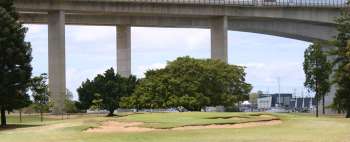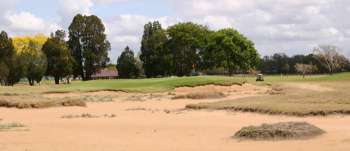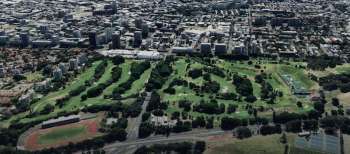Birthday Bash - Clayton's Royal Queensland course turns 5
Back in 2005 the Royal Queensland Golf Club was quite literally at a crossroads. The then state Labour government had announced plans to duplicate the Gateway Bridge, which links the southeastern suburbs of Brisbane to the north but was struggling to handle increased traffic flows. The existing structure already extended across the club’s back nine, and the prospects of playing under another bridge, not to mention the sizeable construction disruptions, forced the club to look for alternatives.
As regular readers will no doubt be aware, the path taken by Royal Queensland was to build an essentially brand new Michael Clayton-designed golf course west of the roadways. In December that course celebrated its 5th birthday, and Australian Golf Digest returned to the club to see how things had matured.
We have noted several times previously in this magazine, just how distinctive the new Royal Queensland course is. The look and feel of the holes is unique to Australia, and the strategy employed throughout the layout is sound. In the years since it was completed the course has continued to mature nicely, with playing surfaces firming up and a number of recently added sandy wastes helping to improve untidy areas and complete an attractive visual picture. To give an idea of how successful the new course has been, prior to the changes the club languished down at number 60 in our ranking of Australia’s Top 100 golf courses. It is now positioned inside the country’s Top 30.
When Royal Queensland was first founded in 1920 parts of its course were constructed atop a reclaimed swamp and with sand that had been dredged from the adjacent Brisbane River. The rest of the site was mostly clay based. Additional areas in the general vicinity had been misused for decades and either left neglected and covered in weed or been used as a makeshift dumping ground. This was the land given as offset to the club for the loss of its eastern parcel, and the land upon which the current 2nd, 3rd, 6th and 7th holes were built. For Clayton, this was certainly no Barnbougle Dunes.
Aside from the fact that most of the holes occupy flat, featureless ground, what’s most impressive about the design work here are the greens and bunkers, which work beautifully in unison to dictate strategy to all manner of player. While most of the driving zones are fairly generous, golfers can’t just bomb away from the tee with impunity because the fairways are full of central bunkers and the greens feature treacherous ridges and swales that complicate play for those approaching from the wrong angle. The best example of this strategic simplicity comes at the mid-length par four 16th, which bends to the left but demands a tee shot out toward the right-hand bunkers in order to avoid a large fig tree on the corner and, more importantly, to enable the golfer to hold its twin-plateau putting green.
As Clayton himself says of the design, “this is not a course where players will grow bored. The best lines to take from the tees and the best shots to play vary from day to day depending on the wind, the position of the flag, the state of one’s game and the state of a match. That is the essence of making the game interesting on more than just a superficial level and Royal Queensland is a course that captures that spirit.”
One hole that illustrates Clayton’s point perfectly well is the drivable par four 12th, already a quasi-signature given its devilish green and the fact that members have mixed aces with double digit disasters. Much like the famous 10th hole at Riviera in California, the key to the 12th is understanding your short game and figuring the best place to approach the day’s pin. The skinny green, set obliquely to the fairway, is a tempting target down-wind or anytime the flag is located on the front. Pushed back, however, the challenge becomes finding an angle off the tee that gives an opportunity to pitch along the length of the green, and that means avoiding a series of sand scrapes through the middle of the fairway.
What do the members think?
Not surprisingly, the members we spoke to about the golf course regularly pointed to the 12th as a hole they either love or love to hate. Few had truly figured the best way to play it. The same could be said of other parts of the course too, with many of the green complexes continuing to befuddle even the most regular players. Greens like the 7th, 10th, 11th, 13th and 14th demand great care and are unforgiving on anyone who ‘short-sides’ themselves.
Overwhelmingly the members were positive about the changes, and especially that it now takes a great deal more thought and strategy to figure the best way to play certain holes. In many ways, this has become the perfect course for regular member play and it would be hard to argue than anything else in Queensland was as stimulating on an ongoing basis.
What do the members miss?
Despite acknowledgments that the new course has improved the golf at Royal Queensland, some members remain attached to the club’s lost riverside holes. These included the iconic par three 14th, which was once compared to the 12th at Augusta National by none other than Norman von Nida.
They also miss the uniformity of the previous bunkers, which were more rounded and generally presented golfers with flat, consistent lies every single time. The twisted, elongated shape of the new bunkers throws up the occasional funky lie and awkward stance. Clayton acknowledges there are difficult sand shots now but argues that, “the bunkers are a significant part of the defence of the golf course. Not always will the player be afforded a perfect lie or a perfectly ‘fair’ shot. Some think that unreasonable, but bunkers are hazards that ought to deliver somewhat random forms of punishment. The odd difficult shot gives the better player an opportunity to show off skills others have not developed. They also give those who have not developed those skills a chance to add another dimension to their game.”
The other criticism of RQ from some quarters is that it has become too forgiving off the tee, especially for good players. Again Clayton dismisses such a notion, describing width and space as essential to allow golfers to, “decide from themselves where best to play.” He adds that while it appears forgiving, the test here is of “accurate driving to position as opposed to simple straight hitting.” Indeed, hitting fairways at Royal Queensland is like hitting greens on The Old Course at St Andrews, irrelevant unless you are leaving your ball in the right area.
What can other clubs learn from Royal Queensland?
Royal Queensland has been the preeminent golfing institution in Brisbane for more than 80 years and the club would have likely survived the upheaval of the new bridge construction with a poorer layout and a less inspired design. That said, the completion of Clayton’s course has attracted a new breed of younger member and in a large way helped restored RQ’s prestige. A fantastic practice facility and soon-to-be-completed $3 Million clubhouse renovation add to the facility and further enhance the club’s reputation.
While not every Australian golf club has the resources available to undertake such drastic transformation, those looking at on-course improvements would do well to keep the success of this project in mind. The brief given to Clayton at the outset wasn’t to make things longer, harder or more dramatic but instead to build a fun, coherent and enjoyable test that would stimulate member attention and make golfers think about each and every shot they hit. On top of that, you’ll barely lose a ball when you play here and foursomes can easily get around in less than four hours. Importantly, the holes themselves are cast upon a somewhat dreary landscape, which means the strategic principles employed can be replicated on almost any site.
Although the duplication of the Gateway Bridge upset many at Royal Queensland and caused some upheaval while officials determined the best path forward, there is no doubt that the club emerged in a stronger position. Fives years on, and with the second bridge now open, the course continues to mature and improve and the membership seems to have gone from strength to strength. No longer at the crossroads, it appears that, for Royal Queensland, the disruption was well worth it.
Darius Oliver, Architecture Editor
Back to NewsMore News
Report reveals golf's $3.3 billion contribution to Australia
AGIC report reveals total annual benefits to the Australian community, economy and environment from golf.
Cape Wickham Links – The Inside Design Story
Co-designer Darius Oliver reveals the truth behind the design of Australia’s premier modern golf course
Min Woo Lee signs up for Aussie PGA title defence
Reigning champion locks in the defence of his title at Royal Queensland Golf Club in November
Have your say on the future of Moore Park Golf
Golfers unite – another one of our cherished public access golf courses is under threat







